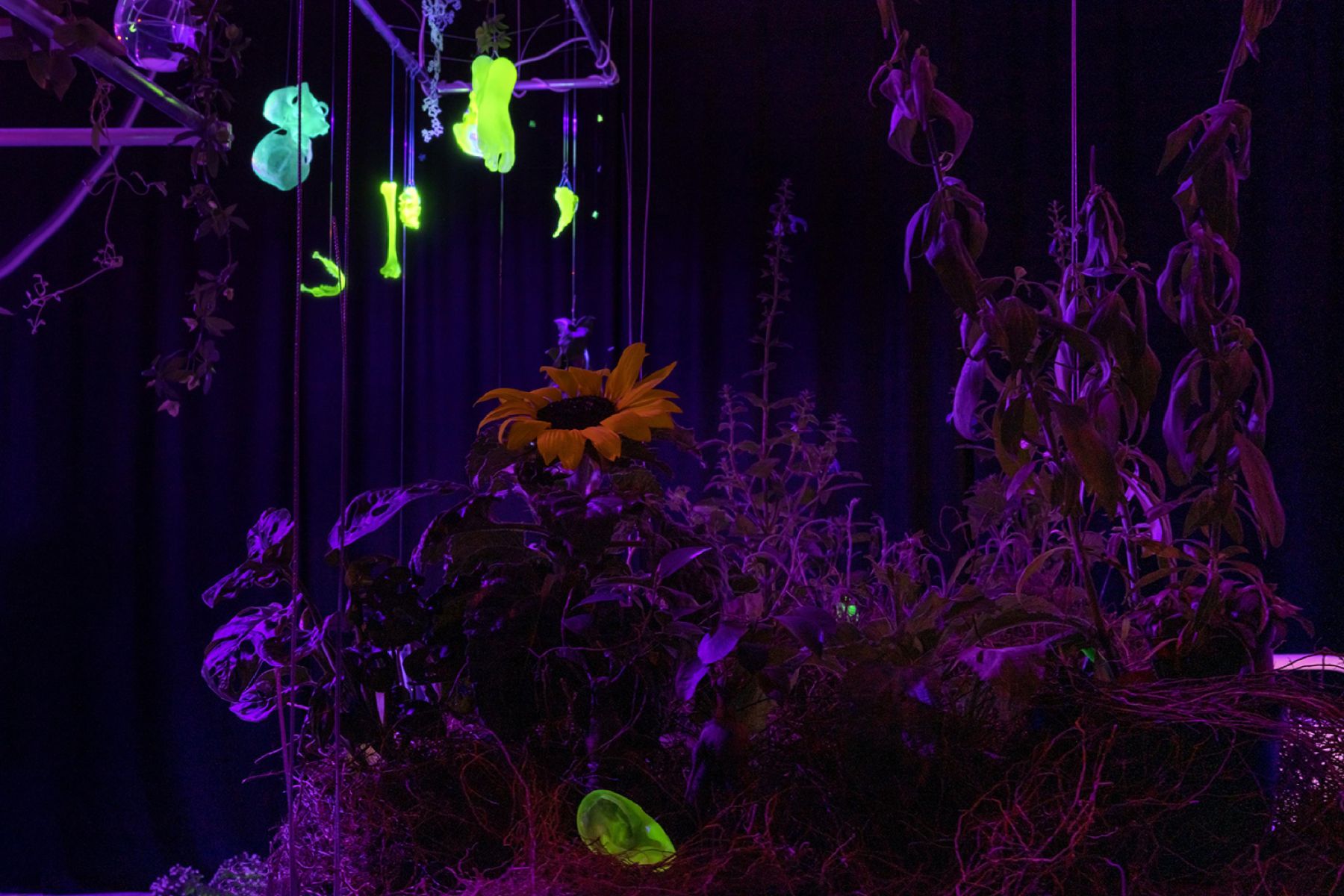Interview Charlie Clark
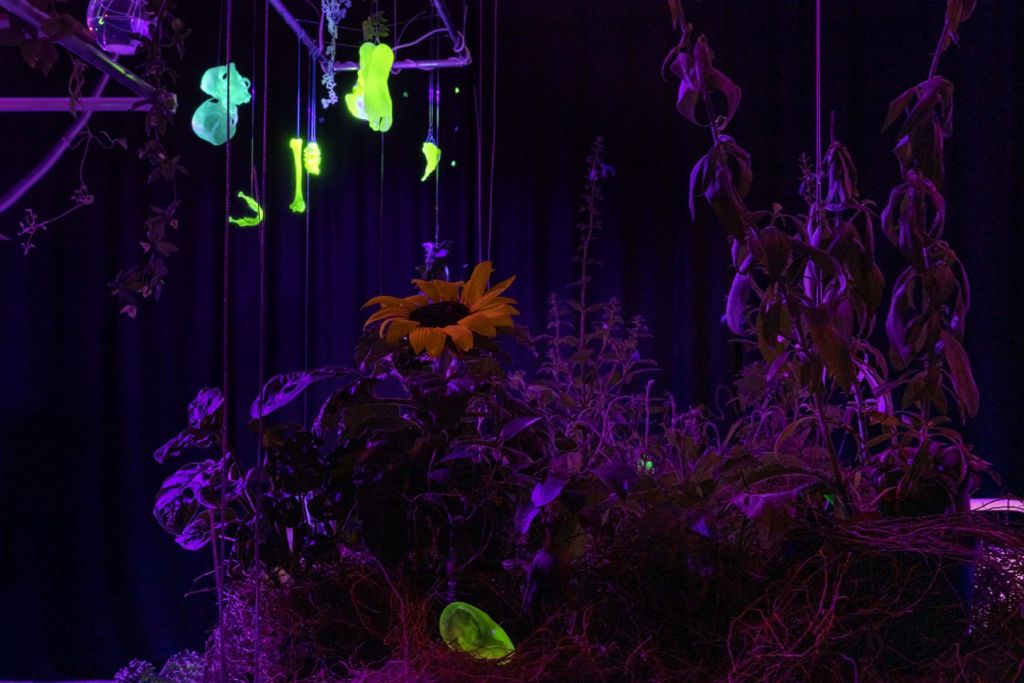
In Metamorphoses, Ovid tells tales of countless transformations undergone by Gods and mortals. Changing into flora and fauna, and sometimes back again, there is a fluidity in the characters’ physical form. These poetic accounts prefigure the concept of transhumanism, popular in today’s cultural imagination, which has been taken on in a new dimension in light of rapid technological development. The thought-provoking ideas around altering the body appeal to academics, artists and writers alike, who use the concept to expand on ideas around the human condition. It’s often referenced in relation to technological development and additions to the human body, but transhumanism can refer to any kind of bodily alteration.
One artist addressing concepts of transhumanism, but through natural means, is emerging artist Jean-François Krebs. Born in France and currently based in London, Krebs’ multidisciplinary work is tactile, visceral and rich in natural imagery. Working in film, installation, performance, glass and textiles, they experiment with the limits of the body, expanding this through a multitude of processes and materials.
With an exciting and varied background in landscape architecture, horticulture, and alternative medicine, Krebs deeply understands the place of the body in nature. His studies in horticulture led him onto a path in landscape architecture, which he left behind when he realised that this took the landscape and the plants out of the central focus. Everything had to be measured and documented, leaving little room for experimentation and feeling things out.
There is a preciousness and a poetry to the way he sees things, which he communicates through the experimental nature of his work. ‘Taboo’ body parts and items are transformed into beautiful textiles, adding poetry to what could otherwise be read as grotesque. Plants play a central part in Krebs’ work, and the transformational process of photosynthesis is one of the key themes in his work. Light has fascinated artists for centuries, but for Krebs, it plays a different role than in the art historical canon. Historically artists have been fascinated with documenting how light falls on objects and the changes that this can effect, but for Jean-François, this interest plays out in the impact of light on living beings and biologies.
Also central to their work, although this is more hidden, is the body. Through subtle imprints and traces, the body appears in glasswork and textiles, and, of course, in performance. As well as leaving traces of his own body, Krebs also works to make their audiences more aware of their own embodied experiences. Using viscous materials like lube and water in his installations draws our attention to our own bodies in playful and slimy ways. Altering and extending the body through these materials becomes a raw yet fresh approach to transhumanist experimentation.
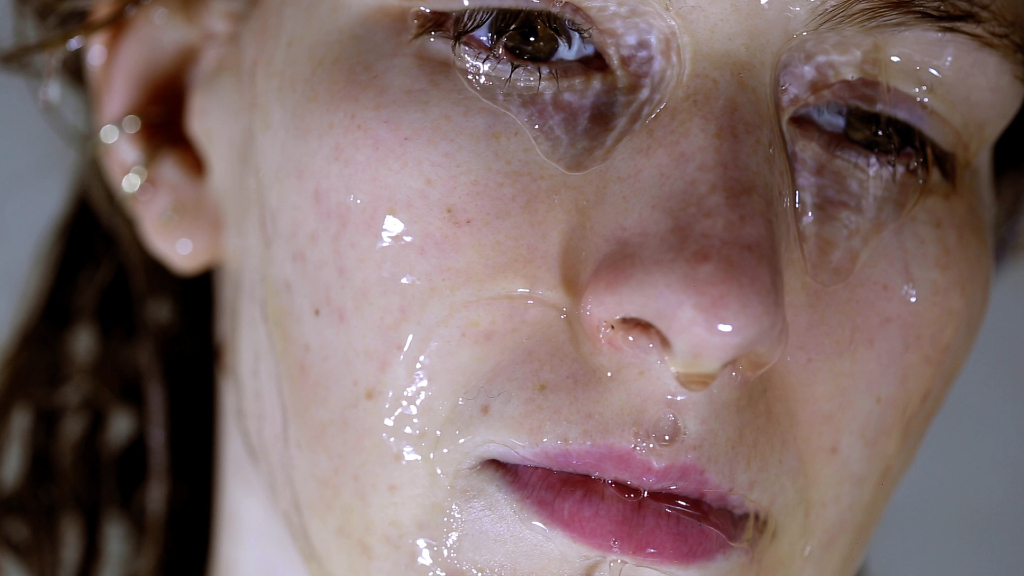
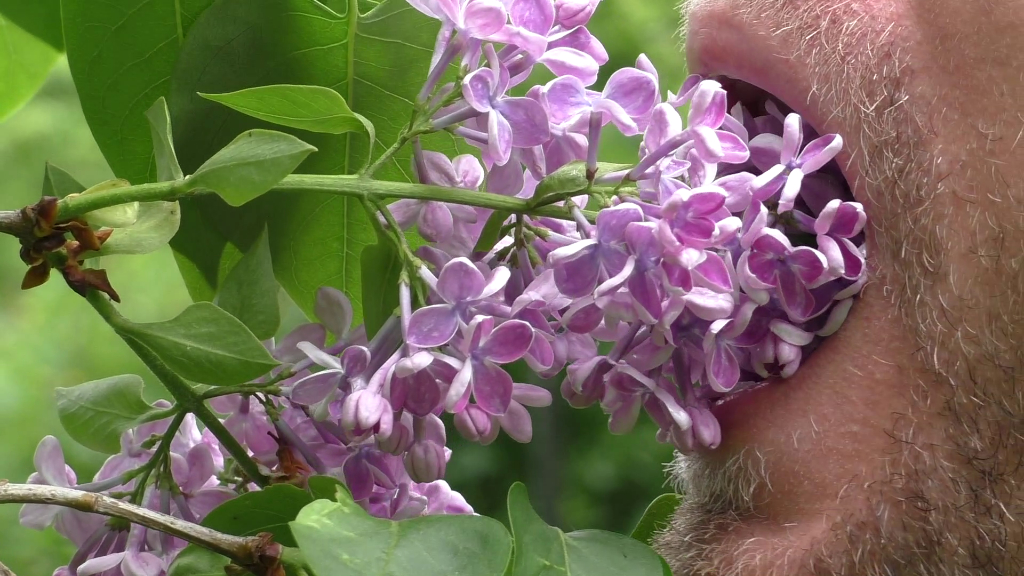
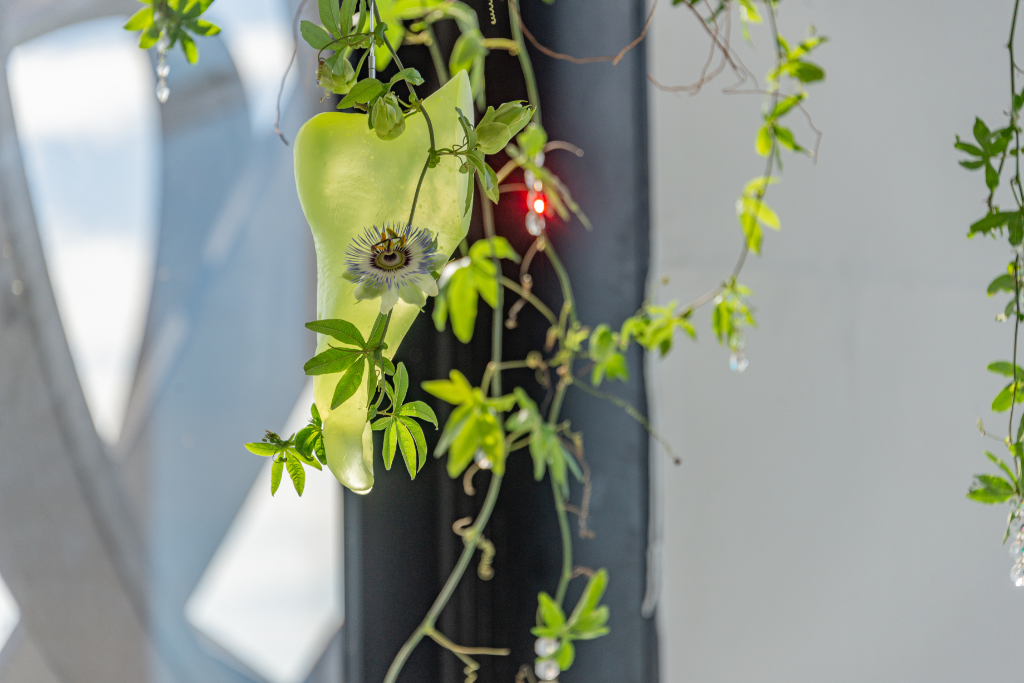
Right: Photophilia, Goldsmiths Degree Show (2022)
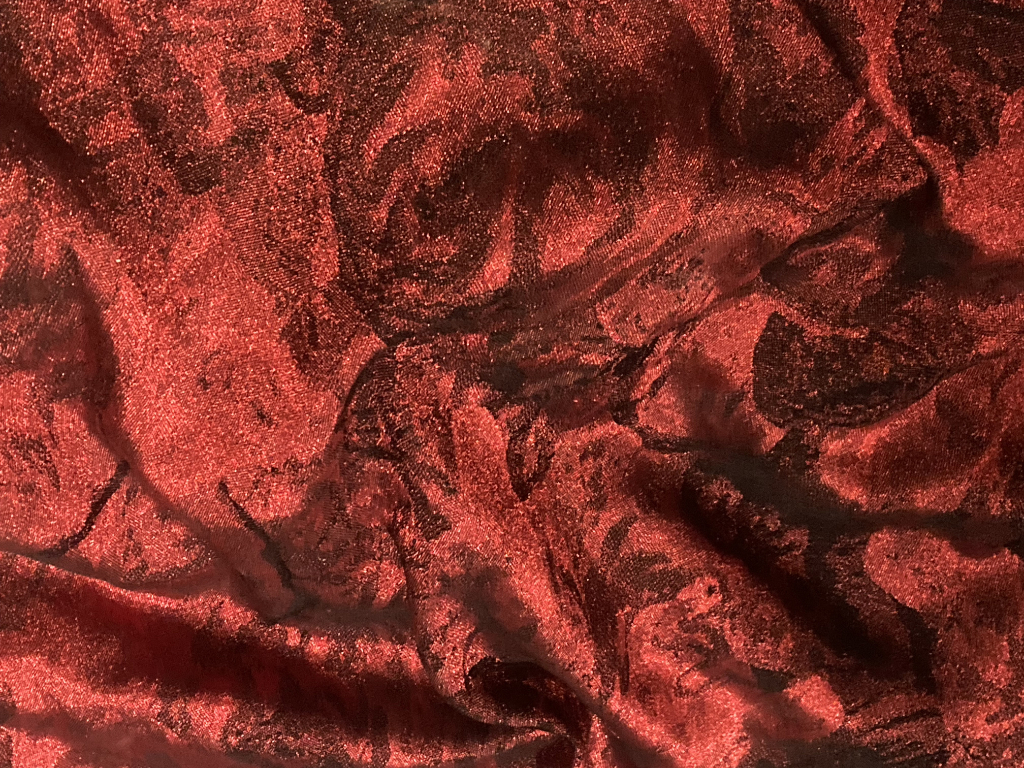
We’ll start with the materials that you work with in your installations. You combine natural materials like plants, water and earth with human-made elements like glass, lubes and textiles. How does this opposition function in your work?
I think it comes mostly from my studies in landscape architecture. I have put it aside for a long time, but it really informs my current practice. The way it thinks about plants as a material is a way of co-creating with living organisms.
For a long time, my main material was my body. I started using my senses to explore landscapes as a kind of analysis and measurement tool. We were encouraged to engage with the landscape by drawing, measuring, and analysing maps. It lacked a kind of viscerality and excitement for me. I was trying to engage in a more empirical way, and it was from this that I started a proper performance art practice.
In these early performances, I would experiment a lot with liquids. I enjoyed how you could only control them to a certain extent and how playful and messy it all was. This early work helped me redefine my body’s limits, physically and metaphorically, especially when I started to work with lubricant. Working with lubricant was never sexual; it was a way to expand the [skin] envelope and its sensations, to integrate the surroundings within the self, and vice versa.
More recently, I found a similar joy when I started working with glass. I was astonished by the liquid behaviour of glass and its potential. I remember an accident that happened when I tried to create a vase. I had a very specific idea in mind for the final piece, but when the glass was blown into a mold, it exploded, and an orange bubble of glass formed and got really close to my arm. I was so disappointed that my initial idea didn’t work out. The following day, I saw the distorted vase, and I fell in love with it. It had some elements of my original design, but it also wore stretch marks, bubbles of different thicknesses and shapes, and an overall solidified liquid shape.
Continuing this exploration of the material aspect, and you may disagree, the materials in your work often seem quite luxurious. There is a really rich quality to a lot of your sculptural work. But you address certain elements in them that are taboo or maybe grotesque, like the tapestry work Daphne that looks like a floral design but is actual images sourced from pornography, layered on top of one another. And they’re almost in the work a bit secretly, hidden in a way. Where do you see the place of these things that are ‘taboo’ in these seemingly luxurious works?
I don’t know if luxurious is really the thing that interests me the most, but maybe there is a certain sense of preciousness. With glass, there is the idea of transcendence: it’s very transformative, using a banal and opaque raw material that becomes transparent in a quasi-alchemical process. Regarding the textile work you are mentioning, I really wanted to use silk, for its sensual and precious qualities, to draw attention away from the triviality of the source material and render it somewhat secondary. I am looking for flowers where most people would not look for a flower. I happened to find it in this erotic material, and I had a poetic reaction. If the source is too obvious, it’s going to be more difficult for people to see the poetry in the same way that I see it. So I think, and maybe I am wrong, that by using ‘precious’ materials, I am helping people to understand my vision a bit better; I’m meeting them halfway. I see it as an act of generosity in a way. In the end, my work is much more innocent in person than when you read about it and maybe more subversive in this way.
It makes a lot of sense what you say about communicating the way that you see things in general, seeing flowers in places that other people don’t. It’s a very poetic way of seeing the world.
There is an element of humour in some of my work, and it doesn’t mean there’s not also something poetic. There is a bit of both in Daphne and in the video Porno Fleur Bleue, in which I put flowers in my mouth and salivate them. It’s a bit more confrontational. Some people find it humoristic and some are quite disturbed by it. The more I see it, the more I’m unsure how I feel. Ultimately, I’m still talking about how humans interact with plants, what vegetal elements we carry in our bodies and our behaviours. The dynamics are really complex; there’s a lot of domination and manipulation going on, both ways, between plants and humans. Sometimes it’s symbiotic, and sometimes it’s more parasitic.
This brings in an Ovidian theme. Not just by titling the textile work ‘Daphne’ but also by looking for the plants in the humans and then that metamorphosis where all of the characters become the flora and the fauna. It’s kind of a back-and-forth.
I think that’s something that we can work on. Yeah, I think in some ways I am interested in transhumanism, how we can expand the human experience through metamorphosis.
Like transhumanism doesn’t have to be an unnatural thing.
Exactly, we can definitely use the botanical as a model. It’s why there’s so much potential in some ecosexual artistic practices. It’s redefining interactions with nature, and it can be very respectful. It can be so many things.
Your background is really interesting. You’ve studied alternative therapies, phytotherapy, energetic healing, and botanical subjects like horticulture. Firstly, What is horticulture, and how does it sit with your work now?
Horticulture is the art of cultivating plants in gardens. We learned about plant biology, how they grow, and how they look in every season. It was a joyful discovery of the vegetal world in a beautiful school in Bois de Vincennes in Paris, alongside an arboretum, which is part of Paris’ botanical garden. After that, I studied landscape architecture at Edinburgh College of Art and at Ecole Nationale Supérieure du Paysage in Versailles. It was completely different; plants started to fade in the background as we were learning about space design, technical drawing, urbanism, and concrete. Plants were often seen as mere tools to build functional spaces.
All these different studies seem to be combined in your work, especially architecture, for example, with the scaffolding in your recent installations and the fact that you’re interested in how the body moves in these spaces. The alchemical and remedying elements in them almost make it feel like a shop; it’s really inviting. I think that’s why they’re so great, these installations because they seem to be offering you different remedies.
I enjoy people interacting with my installations as if they were inhabiting it. The spatial experience allows them to be immersed further into the work. For my last installation, the triptych Light reaction, Dark reaction and Photophilia, which were shown in the same exhibition space for 2 months, I would like its final form to be more architectural and permanent, getting closer to the plant’s temporality.
We’ve spoken before about the natural components found in plants, which is something that draws you to work with these natural forms. Could you speak a bit about that and how you choose the plants that you work with?
When I started to look at plants again in the context of my artistic practice, I was interested in the transformational aspect they could offer when interacting with the human body and consciousness. I wanted to see how plants can be a transformational tool. Supposedly magical properties are often linked to biological properties, and [I was interested in] how plants are producing substances for themselves. Initially, they don’t produce a substance for us. Everything in the plant is something [it has made] for itself first and foremost, like containing a chemical to fight a case of fungi, infection or parasites. Then when humans absorb it, we find that some vegetal substances affect us. I was interested in how certain vegetal substances can transform our metabolism and cure us or how traditional psychedelic plant usage can transform human consciousness. Understanding what a certain compound does for the plant’s biology – acting as a defence mechanism or to attract pollinators – helps to adopt a vegetal perspective, leaving a consumerist anthropocentric attitude behind in favour of a biocentric vision.
Liquidness also appears a lot in your work. For example, you use lube in some of your performances, videos and installations in ways that are really fun but also jarring and visceral. Could you tell us about why you’re drawn to liquids in your work and lubes? Maybe you could talk a bit about the installation at the Melle Biennale.
Liquidity and touch were the first focal points of my artistic practice. In early performance works, I wanted to reconnect with a twin sister, looking at life before birth. This is why my interest in the liquid state of life was very strong, a state of union and immersion.
It’s also the pre-human condition that interested me. I used lubricant a lot because it was a way to produce a kind of membrane around the body that would extend and break down its limits. I thought lubricant was a good way to work on consciousness through hyper-tactility.
For my installation Amniov at the Melle Biennale, I was working in an old ‘lavoir’. It was a really beautiful space with a river running through it. I wanted my intervention to be reminiscent of the usage of the washhouse, with huge sheets of silicone that visually resembled cloth or bed linen in water. They were very ghost-like and had this tactile quality of human skin. I was playing with the idea of a ghostly, tactile memory, the repeated movement of labour in the washhouse. It was a space of very intense physical labour, probably very painful in cold water, but also a place of political power, and resistance, where a lot of things were shared and being said. Body fluids from fabrics were being washed away, mixing in the water. Secrets revealed in liquid.
I installed a two-metre-long metal beam on the ceiling. It was full of powder lubricant, a 100% sustainable formula that I created in collaboration with a pharmacist friend of mine. Every day the beam would vibrate and the powder would fall, creating a lubricant membrane on the surface of the water that people could play with. It created an opportunity for people to reconnect with their own skin, expand its limits and have a collective haptic experience.
And become more aware of their bodies as well… Coming back to the performance aspect of your work, in the past, you have performed as a drag character, Wanda, but since you moved away from that. I was wondering where performance sits in your work now and if you’ve got any upcoming performances planned.
I did perform as a drag queen, yes, in Edinburgh and in Glasgow, but frankly, I was a depressing drag queen in a club context. Looking back at it, I don’t think I was really doing drag; I was duplicating myself. I felt more true to Wanda (pronounced Vanda) when I moved this practice from night clubs to the quieter setting of a library or my own apartment. Recently Wanda inspired my friend Nana Wolke with a series of paintings soon to be shown at the Nicoletti Contemporary in London.
I also worked a lot with this entity, Defense Tactile, with liquid and haptic performances. Blessing, ointments, washing rituals, Défense tactile was almost a personification of lubricant, an entity that would help to expand consciousness through touch.
And coming back to the Melle Biennale piece, Amniov, the lubricant powder was running through slits in the metal beam in the shape of scars on my body. It was the first time I felt my flesh symbolically be a part of a sculpture or an installation and so become performative without me being there.
Solitude or loneliness; how do you spend your time alone?
Being in bed in my own time is a guilty pleasure… It’s a really bad habit, I know. I think I am happy alone, but I am also very sociable, and sometimes I don’t recognise when I feel lonely.
You couldn’t live without…
Sunny days.

